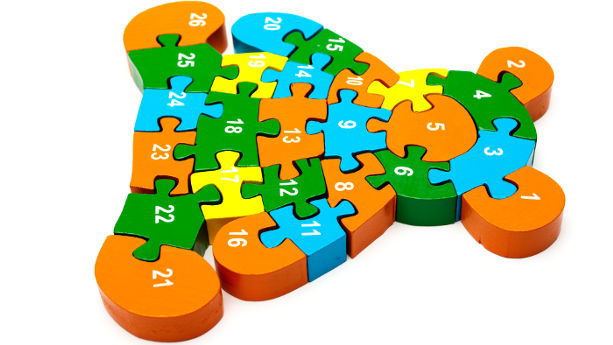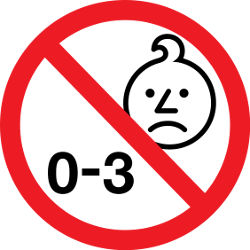
Toys and certain children’s products sold in the European Union are subject must adhere to small parts restrictions. These restriction in turn depend on the age group that the product belongs to. In some cases, small parts are banned , while other situations require warning texts to be applied.
In this guide, we take a closer look at the Toy Safety Directive and the General Product Safety Directive (GPSR) in relation to small part bans and warnings in the EU.
Content Overview

FREE CONSULTATION CALL (US, EU & UK)
- Request a free 30-minute call with Ivan Malloci to learn how we can help you with:
- Find product requirements
- Certification and labeling
- Lab testing
Which products are subject to small parts bans and warnings?
The explanatory Guidance Document on the Application of Directive 2009/48/EC on the Safety of Toys indicates that small parts are banned in certain products meant for children under 36 months because of the danger of a choking.
Additionally, there are warning label requirements for products intended for children aged over 36 months.
Small parts ban: 0 to 36 months of age
Certain toys, and articles containing small parts, are banned for children aged under 36 months.
According to the Tukes.fi guidance page on “Small parts in toys and other products for children”, this includes the following products:
- Dolls
- Rattles
- Soother holders
- Furniture intended for young children
While not mentioned by Tukes.fi, our research indicate that some of the products mentioned are covered by the Toy Safety Directive, while others, such as soother holders or furniture, are covered by the General Product Safety Regulation.
Note that there are EN standards that are harmonised under the General Product Safety Regulation that cover soother holders and children’s furniture. For example:
a. EN 12586 – Child care articles – Soother holder – Safety requirements and test methods
b. EN 1130 – Children’s furniture – Cribs – Safety requirements and test methods
Such standards can also include provisions that concern small parts.
Small part ban: Toys containing small parts and intended to be put into the mouth of the children
Toys and their detachable or component parts that are intended to be placed in the mouth must be big enough to prevent the risk of being swallowed.
Specifically, the Guidance Document on the Application of Directive 2009/48/EC on the Safety of Toys explains that removable or detachable small parts in toys intended to be put in the mouth are banned, even when they are intended for children that are older than 36 months.
Here are a few examples of such products:
- Toy instruments
- Whistle with ball
- Trumpet with drum
Small parts warnings: 36 months of age and over
According to the Guidance Document No. 11, products containing small parts that are intended for children that have at least 36 months must bear:
- An age warning pictogram; or
- The warning statement “Not suitable for children under 36 months”; or
- The warning statement “Not suitable for children under 3 years”
Products meant for children aged 36 months and over include:
- Foam puzzles without interchangeable pieces
- Wooden puzzle with multiple pieces
- Mosaic puzzle with many pieces
What is the definition of small parts in the EU?
The Tukes.fi guidance page on “Small parts in toys and other products for children” defines a “small part” as a component that fits inside a small parts testing cylinder (as described on EN 71-1 – Safety of toys – Part 1: Mechanical and physical properties) that:
- Has a height of 57.1 mm
- Has a diameter of 31.77 mm
Note that the cylinder simulates the size of a three-year-old child’s throat.
The guidance page states that the small part can be:
- A whole toy
- A component of the toy
- A part of the toy that can break off during testing
Are toys and children’s products with small parts banned in the EU?
Yes, the EU bans certain toys and children’s products from having small parts.
According to the Guidance Document on the Application of Directive 2009/48/EC on the Safety of Toys, small parts are prohibited in:
- Toys meant for children aged under 36 months
- Toys containing small parts and meant for children to place in their mouth
Toys containing small parts and intended to be used by children under 36 months of age
Examples of banned products that contain small parts and are meant for use by children aged under 36 months include:
- Textile toys
- Rattles
- Soft-filled toys
- Baby toys
Toys containing small parts and intended to be put into the mouth of the children
The guidance document notes that the Toy Safety Directive prohibits toys that are meant to be put in the mouth, from being too small having small detachable parts. Here are a few examples of such products:
- Toy instruments
- Small balls
- Balloons
- Hemispherical shaped toys
Other banned children’s products
The Tukes.fi guidance page lists childcare products that are meant for children but are also prohibited if they contain small parts. These products include:
- Furniture for young children
- Pushchairs
- Sitting supports
- Soother holders
- Rattles
Note that, even though these products are not toys, and thus they are not covered by the Toy Safety Directive, these products are still covered by the General Product Safety Regulation.
Which products require small parts warning in the EU?
According to the Toy Safety Directive, toys not meant to be used by children aged under 36 months and that might pose a danger to them must bear a small parts warning statement or a warning graphic symbol. We explain which warnings and provide examples of such products in later sections.
The Guidance Document on the Application of Directive 2009/48/EC on the Safety of Toys specifies how you should add the hazard warning to the toy, and to the instructions, where appropriate. According to the document, you must accompany the warning with a short indication of the hazard that necessitates the safety measure, such as:
- Small parts (choking)
- Small balls – choking
How do I know which age group my product belongs to?
The Toy Safety Directive Guidance Document No 11 provides examples of toys for different age groups; specifically either for children aged under 36 months, or children aged 36 months and over.
The guidance document also refers to ISO/TR 8124-8 – Safety of toys – Part 8: Age Determination Guidelines, which provides guidelines for determining the earliest age at which young children can begin to play with specific toys.
0 to 36 months of age
Here are a few products – and their criteria – for children aged from birth to 36 months:
- Foam puzzle – interchangeable, interconnected
- Padded fabric doll – simple, flexible, non-removable clothes
- Soft toy attached to key ring – simple design, soft stuffed, cuddly
- Wheeled fire truck toy – proportional, realistic details
36 months of age and over
Here are the criteria for some products meant for children aged 36 months and over:
- Wooden puzzle – big, simple shapes, not interlocking
- Stuffed pencil case – simple design, soft studded, cuddly, easy to use
- Wheeled fire truck toy – proportional vehicle, realistic details
Small part warning text examples

According to the Toy Safety Directive and its accompanying explanatory Guidance Document, toys that are or contain small parts – and thus might pose a risk of choking to those children – must bear either the graphic pictogram above or one of the following text warnings:
a. “Warning: Not suitable for children under 36 months. Small parts. Choking hazard”
b. “Warning: Not suitable for children under 36 months. Small parts (choking)”
c. “Warning: Not suitable for children under 36 months. Small balls – choking”
d. “Warning: Not suitable for children under three years. Small parts. Choking hazard”
e. “Warning: Not suitable for children under three years. Small parts (choking)”
f. “Warning: Not suitable for children under three years. Small balls – choking”
The graphic pictogram, as above, must have:
- A red circle and stroke
- A white background
- A face outlined in black
- The 0-3 age range, also in black
Should the warning text be printed on the product or the packaging?
According to Article 11 of the Toy Safety Directive, warning labels must be clearly visible and readable. They must be affixed on the product or the packaging and, when relevant, in the instruction manual that accompanies the toy.
Note that if you sell the toy without packaging, you must affix the warning label on the product.
Is there any test method for assessing small parts hazards?
According to the Tukes.fi page on small parts in toys and other children’s products, the method used to assess whether a product poses a small parts hazard uses a small parts test cylinder from the EN 71-1 standard.
The cylinder has a height of 57.1 mm, a diameter of 31.7 mm, and approximates the size of the fully expanded throat of a 3-year-old child. Toys, and parts thereof, that fit into the cylinder:
- Fail the test;
- Do not comply with safety requirements; and
- Must not be sold due to the product’s choking hazard
Amazon requirements concerning small parts and warnings
Amazon requires sellers to comply with the Toy Safety Directive, which specifies small parts warning statement requirements.
Also, Amazon reminds sellers that these requirements do not necessarily only apply to products listed under Amazon’s “Toys” category.
In some cases, toys that are required to bear a small part warning might be listed under different categories, such as some foodstuff containing toys or specific childcare products that have “play features”. Here we list some examples:
- Toys in cereals
- Toys in chips
- Toys in chocolate
- Bathing crayons for children
How do I make sure that my supplier applies the correct warning?
You should never assume that manufacturers outside the European Union are aware of small parts warnings and age group classifications in the European Union. As such, importers must always provide ready-made labelling files directly to the manufacturer before entering production. Warning labels are often part of the product packaging artwork files.
General Product Safety Regulation (GPSR)
The GPSR covers children’s products that are not toys, which includes children’s furniture, pacifiers, baby carriers and other products for infants and children. The basic principle under the GPSR is that all products must be safe. Hence, if small parts renders a product unsafe it is likely to be non-compliant with the GPSR even if this is not explicitly addressed.
The GPSR also sets requirements concerning warnings, which could in some cases also relate to small parts. Further, it also mentions age suitability labelling, which again can relate to small parts.
Finally, the GPSR requires compliance with applicable EN standards, some of which are harmonised. These can also cover requirements that concern small parts.
In short, it’s essential that all children’s products, toys or non-toys, are safe and ensuring that a product does not contain hazardous small parts is therefore essential.
















